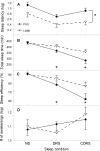Wake detection capacity of actigraphy during sleep
- PMID: 17969470
- PMCID: PMC2266273
- DOI: 10.1093/sleep/30.10.1362
Wake detection capacity of actigraphy during sleep
Abstract
Study objectives: To evaluate the ability of actigraphy compared to polysomnography (PSG) to detect wakefulness in subjects submitted to 3 sleep conditions with different amounts of wakefulness: a nocturnal sleep episode and 2 daytime recovery sleep episodes, one with placebo and one with caffeine. A second objective was to compare the ability of 4 different scoring algorithms (2 threshold algorithms and 2 regression analysis algorithms) to detect wake in the 3 sleep conditions.
Design: Three nights of simultaneous actigraphy (Actiwatch-L, Mini-Mitter/Respironics) and PSG recordings in a within-subject design.
Setting: Chronobiology laboratory.
Participants: Fifteen healthy subjects aged between 20 and 60 years (7M, 8F).
Interventions: 200 mg of caffeine and daytime recovery sleep.
Results: An epoch-by-epoch comparison between actigraphy and PSG showed a significant decrease in actigraphy accuracy with increased wakefulness in sleep conditions due to the low sleep specificity of actigraphy (generally <50%). Actigraphy overestimated total sleep time and sleep efficiency more strongly in conditions involving more wakefulness. Compared to the 2 regression algorithms, the 2 threshold algorithms were less able to detect wake when the sleep episode involved more wakefulness, and they tended to alternate more between wake and sleep in the scoring of long periods of wakefulness resulting in an overestimation of the number of awakenings.
Conclusion: The very low ability of actigraphy to detect wakefulness casts doubt on its validity to measure sleep quality in clinical populations with fragmented sleep or in situations where the sleep-wake cycle is challenged, such as jet lag and shift work.
Figures



References
-
- Ancoli-Israel S, Cole R, Alessi C, Chambers M, Moorcroft W, Pollack CP. The role of actigraphy in the study of sleep and circadian rhythms. Sleep. 2003;26:342–92. - PubMed
-
- Acebo C, LeBourgeois MK. Actigraphy. Respir Care Clin. 2006;12:23–30. - PubMed
-
- Blood ML, Sack RL, Percy DC, Pen JC. A comparison of sleep detection by wrist actigraphy, behavioral response, and polysomnography. Sleep. 1997;20:388–95. - PubMed
-
- de Souza L, Benedito-Silva AA, Nogueira Pires ML, Poyares D, Tufik S, Calil HM. Further validation of actigraphy for sleep studies. Sleep. 2003;26:81–5. - PubMed
-
- Kushida CA, Chang A, Gadkary C, Guilleminault C, Carrillo O, Dement WC. Comparison of actigraphic, polysomnographic, and subjective assessment of sleep parameters in sleep-disordered patients. Sleep Med. 2001;2:389–96. - PubMed
Publication types
MeSH terms
LinkOut - more resources
Full Text Sources
Other Literature Sources
Medical

